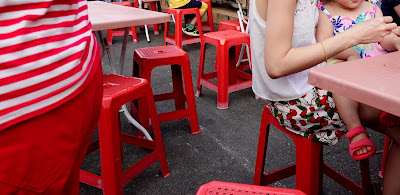Moments of Serendipity
Sometimes when shooting on the street or while traveling, I am lucky enough to have captured moments that make a photo interesting. I don't call myself good at taking photo, as I haven't done it enough to get consistent results in quality. But some photos I really like because the moments frozen in the frame are, for various reasons, interesting to look at.
One that I like is this photo. Photographed in the courtyard
of the Piazza del Duomo, Milan, a place that was teeming with visitors in one
late March 2018. The weather towards the beginning of spring is still
quite cold. People walk around trying to get warm. I captured random moments,
without stopping to see what was recorded on the camera. These two events
happened to be recorded in one frame. I titled it "Two Ways to Get Rid of
the Cold".
 |
| Milan, 29 Maret 2018 |
 |
| Milan, 29 Maret 2018 |
We can't control what goes on in the open space. People come and go, events flash and change rapidly. The weather also adds to the factor of uncertainty. High uncertainty opens the opportunity for many coincidences. In street photography, we often have pure random luck, which is why we should always be aware and ready to shoot. The surprises that await when you check your camera shots are part of the fun. Luck only comes to those who are ready.
Serendipity is a happy coincidence. We plan for something,
but instead find something different that was not planned. Moments of
serendipity are moments when we have luck and unexpected discoveries while
looking for something different, or not looking for it at all.
Serendipity also often occurs when we surf the internet,
watch on YouTube, or shop online. Often times, when we are using search engines
on the internet, our attention is diverted in another direction by the links
that appear in the search results. We open it and then carry on to find new
things that are far different from our original intention. We keep exploring,
stopping for a while at a page and then moving on until we finally have
gathered more than enough information we need, or filled a shopping cart for
something we didn't intend at first.
Serendipity is also a consideration in social media design.
If you find social media layout designs changing, don't be surprised, they're
just trying to increase the serendipity factor - perhaps at the expense of the
comfort of users who are used to the old design.
Many discoveries in science also occur in moments of
serendipity. The most famous of these are the discoveries of penicillin,
x-rays, microwave ovens, Post-It notes, and velcro. The stories behind this
discovery show how the scientists and researchers got things that were very
different from what they originally planned, and the coincidence led to
unexpected new discoveries. It's like opening the door to a hidden treasure.
When visualized, it is similar to a Minesweeper game. When
we click a box, it will open new boxes around it. If we are unlucky, we
even open the box containing the explosion. But for that bad luck, the word
serendipity is not used.
The first noted use of "serendipity" in the English language was by Horace Walpole on 28 January 1754. In a letter he wrote to his friend Horace Mann, Walpole explained an unexpected discovery he had made about a lost painting of Bianca Cappello by Giorgio Vasari by reference to a Persian fairy tale, The Three Princes of Serendip. The princes, he told his correspondent, were "always making discoveries, by accidents and sagacity, of things which they were not in quest of." The name comes from Serendip, an old name for Sri Lanka (Ceylon). It is derived from the Sanskrit Siṃhaladvīpaḥ (Siṃhalaḥ, Sri Lanka + dvīpaḥ, island).
The word has been exported into many other languages, with the general meaning of “unexpected discovery” or “fortunate chance”, For example: serendipidade in Portuguese, serendipia (Spain), serendipität (Germany), sérendipité (French), serendipità (Italy), serendipiteit (Netherlands), serendipitet (Swedish, Danish and Norwegian), serendipiteetti (Finland), and sieriendipnost (Russian).Unfortunately, this word has not been officially absorbed into the Indonesian language. It is still not found in the Indonesian dictionary. I don't know why the compilers of that dictionary seem reluctant to absorb the word into “serendipitas”. Even though the word is very popular and the rules to export it are the same as the “singularitas” which comes from singularity and has already been accepted as one of the entries.
Perhaps because “serendipitas” is not a term required by certain fields of science, unlike “singularitas” which is a term in Astronomy, so it is assumed that its absorption is not urgent. I hope one day this beautiful word will be accepted into Indonesian dictionary. For now, let's just use it as we like a beautiful sounding word.
So, what's your serendipity moment today?




Finally an article talk also about photo, a little. Sometimes dictionary won't add new terms to preserve own language, look what happen with English terms, but this is a concept not only a word, and root is ancient, so I agree with you. Well done!
BalasHapusYes, because street photo is a good case of serendipity..
HapusThanks a lot for reading 😊